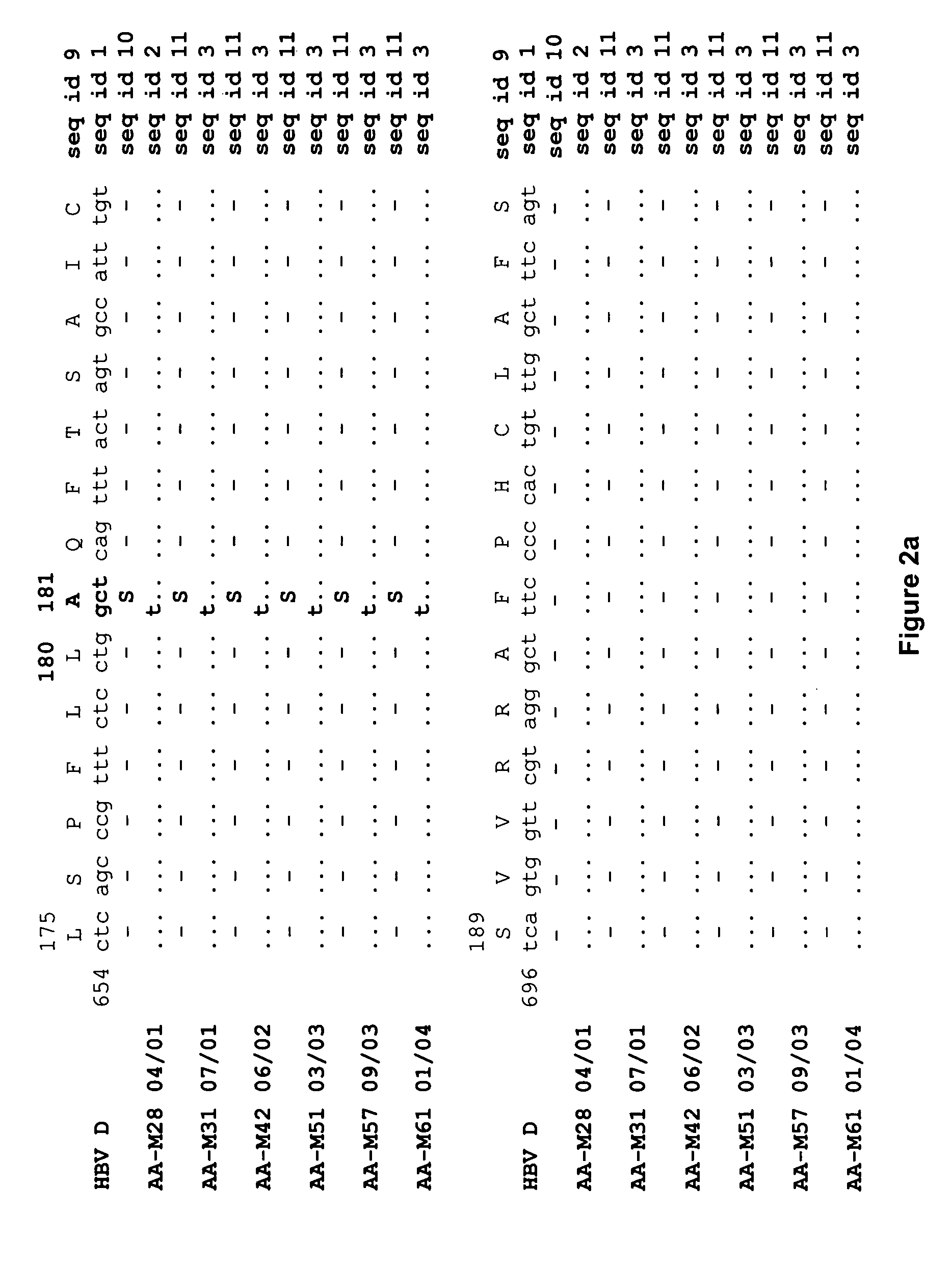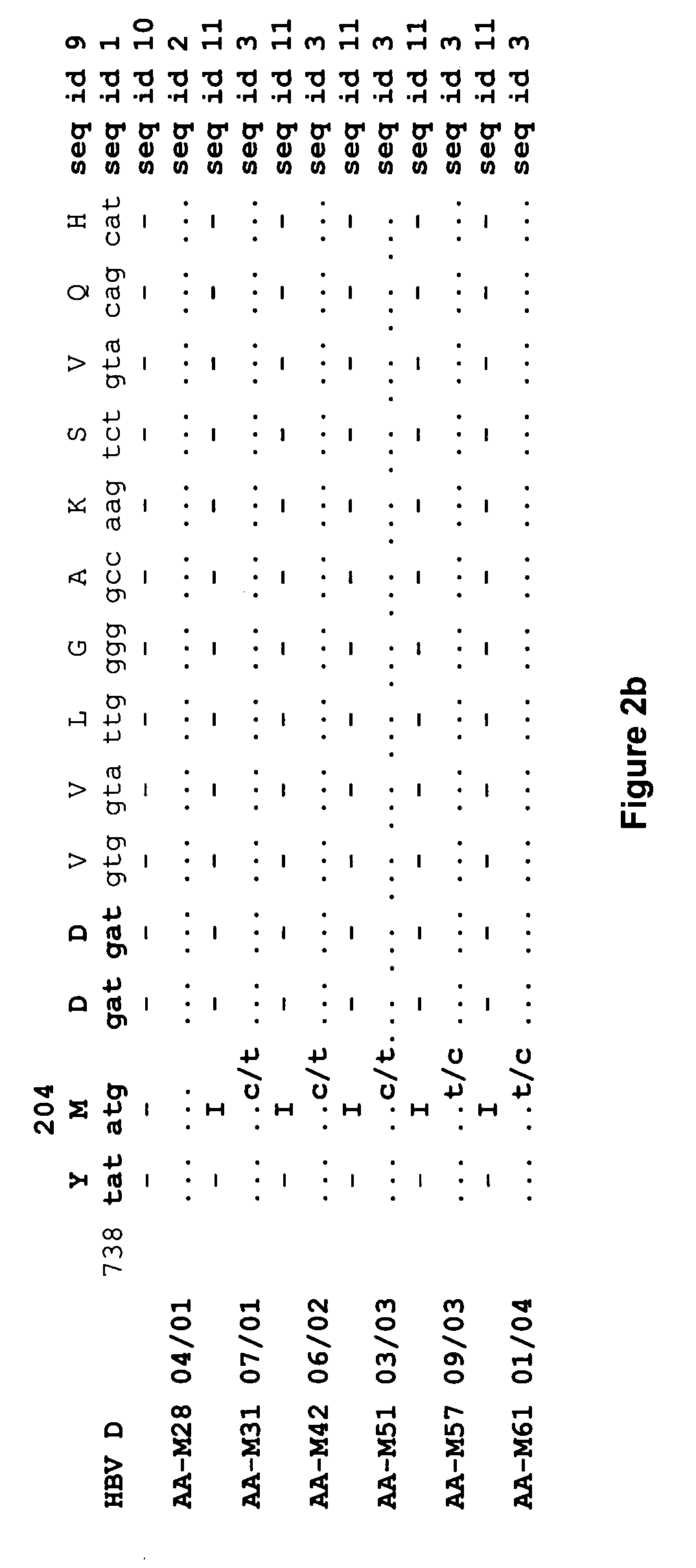Hepatitis-B viral variants with reduced susceptibility to nucleoside analogs and uses thereof
a nucleoside analog and variant technology, applied in the field of hepatitis b virus, can solve the problems of affecting the survival rate of patients, and affecting the development of mutants causing drug resistance,
- Summary
- Abstract
- Description
- Claims
- Application Information
AI Technical Summary
Benefits of technology
Problems solved by technology
Method used
Image
Examples
example 1
A New Mutation Pattern Developed in a HBV Strain During 3TC-Treatment Shows Cross-Resistance to Adefovir Dipivoxil Treatment
case study
[0176] In work leading to the present invention, the inventors have identified a patient that was chronically infected with HBV. The patient was a 43-year old Caucasian male indicated with patient AA with known HBV infection since 1990, diagnosed during a routine check-up. A liver biopsy in 1999 revealed chronic active hepatitis (CAH) with a histological activity index of six according to Knodell et al. The patient was HbeAg positive, anti-Hbe negative as well as positive for HBV DNA. HBV DNA levels were measured by using a commercial liquid-hybridization assay (Digene, Maryland, US), with the lower limit of detection of this assay being 5 pg / mL of viral DNA.
[0177] As represented in FIG. 1, IFN therapy, 9 MU / TIW (million units / three times in one week), was given for 9 months (in 1999). The patient did not show an ALT decrease or virological response (HBV DNA level was 396 pg / ml at the end of IFN treatment). As the viral load failed to decrease within this period, the patient discon...
example 2
In-Vitro Confirmation of the Drug-Resistance of the Newly Mutated HBV Strain
Isolation of HBV DNA From Serum Samples and Amplifacation of Full-Length HBV Genomes
[0185] DNA was extracted from 200 μl serum samples using High Pure Viral Nucleic Acid kit (Roche, Ind., USA) according to the manufacturer's instructions. The full-length HBV DNA genome was amplified as previously reported by Gunther et al., 1995 using a PCR system containing 50 mM KCl, 1.5 mM MgCl2, 0.35 mM Tris-HCl (pH 8.3), 200 μM dNTP, 5 U of Taq DNA polymerase and 0.3 μM of each of the following primers: [P1, 5′-CCGGA AAGCTT GAGCTC TTCTTTTT CACCTC TGCCT AATCA-3′ (nucleotide 1821-1841; SEQ ID NO 25); P2, 5′-CCGGA AAGCTT GAGCTC TTCAAAAA GTTGC ATGGTG CTGG-3′ (nucleotide 1823-1806; SEQ ID NO 26)] and 2 μl of extracted DNA in a total volume of 50 μl PCR reaction was run for 40 cycles with denaturation at 94° C. for 40 s, annealing at 60° C. for 1.5 min and elongation at 68° C. for 3 min, with an addition of 2 min after eac...
PUM
| Property | Measurement | Unit |
|---|---|---|
| pH | aaaaa | aaaaa |
| volume | aaaaa | aaaaa |
| volume | aaaaa | aaaaa |
Abstract
Description
Claims
Application Information
 Login to View More
Login to View More - R&D
- Intellectual Property
- Life Sciences
- Materials
- Tech Scout
- Unparalleled Data Quality
- Higher Quality Content
- 60% Fewer Hallucinations
Browse by: Latest US Patents, China's latest patents, Technical Efficacy Thesaurus, Application Domain, Technology Topic, Popular Technical Reports.
© 2025 PatSnap. All rights reserved.Legal|Privacy policy|Modern Slavery Act Transparency Statement|Sitemap|About US| Contact US: help@patsnap.com



